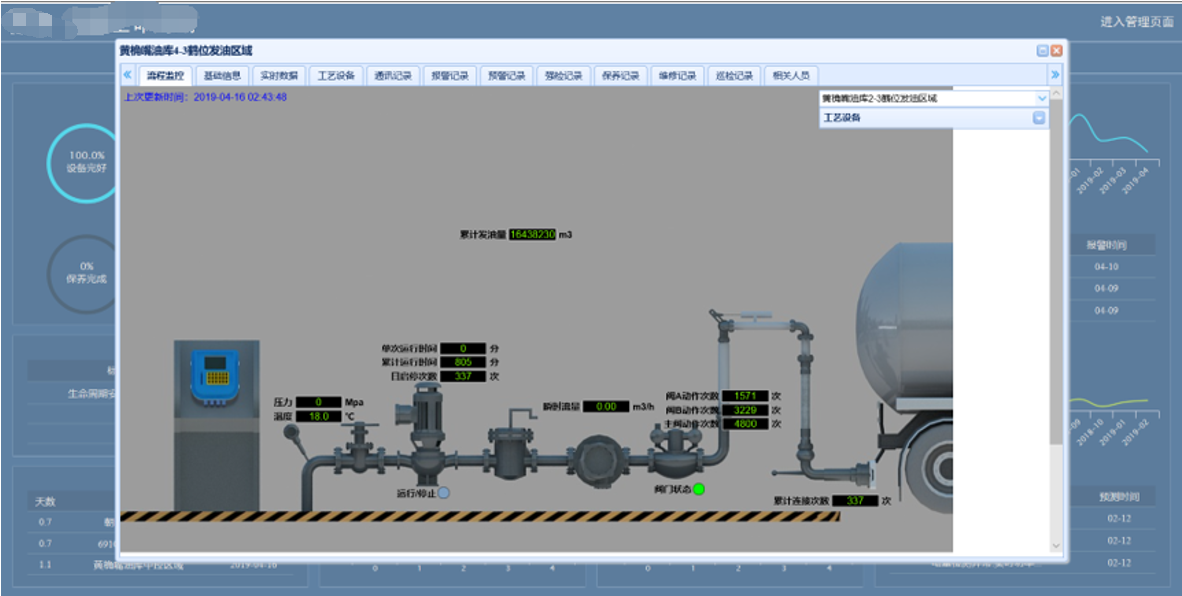Oil depot intelligent safety management and control platform
Release time:2022-09-21Viewers:

I. Overview
This platform uses information technology and Internet of Things technology to add data acquisition gateways or wireless sensors in dangerous areas such as oil depots, gas stations, and chemical industries. The safety-related signals of signals and manual alarm signals are collected on the central server of the management center, and recorded, displayed, analyzed, and alarmed. track. It also provides early warning prompts for the detection and failure of safety equipment, and supervises the normal use of the equipment.
2. Features
Provincial company centralized monitoring: It is mainly built in the central control monitoring center of the headquarters. Its main functions include: monitoring point status statistics, notification announcements, disconnected site prompts, alarm equipment statistics, fault site statistics, alarm historical trends, real-time alarm information, and forecasting Statistics, forecast information, site distribution map, site current status monitoring.
Safety early warning platform: site management of warehouses, gas stations, hazardous chemical sites, electronic files of safety equipment, data collection and configuration of safety equipment, online map management of sites, repair/maintenance work order tracking, alarm record query, historical data analysis.
Data collection service: The data collection service is built in the central server, and the data collection can be carried out by means of RS-485/TCP/IP through the on-site communication gateway, or through the Internet of Things such as NB-IOT and 4G. The number of sites can be freely increased or decreased through configuration, flexible configuration, and automatic detection and reconnection of offline devices at regular intervals.
Handheld inspection terminal: Inspectors can perform NFC scanning inspection, taking pictures, applying for fault insurance, maintenance registration, maintenance registration, etc. to the on-site inspection point through the handheld terminal, and can directly submit and upload to the server.
Video surveillance system: with NVS as the core, it is mainly composed of front-end digital cameras, network equipment, management and storage servers, and monitoring terminals. The system adopts a modular structure, which is scalable and can operate normally in harsh environments and low power consumption.
Fire alarm system: It is composed of controller, display panel, sound and light alarm, photosensitive smoke detector and manual alarm button. At the same time, it can be integrated with emergency broadcasting system. The central control room can communicate with the fire alarm controller in real time to monitor and record the alarm information.
Perimeter protection system: The pulse electronic fence host transmits the alarm signal to the control keyboard of the back-end control center through the signal transmission device.
Combustible gas alarm system: It is composed of combustible gas detector and controller. Combustible gas detectors are installed in key areas such as oil generating area, pump room, oil unloading area, and tank area. Once oil leakage occurs, the alarm signal will be sent to the remote immediately. monitor computer.
This platform uses information technology and Internet of Things technology to add data acquisition gateways or wireless sensors in dangerous areas such as oil depots, gas stations, and chemical industries. The safety-related signals of signals and manual alarm signals are collected on the central server of the management center, and recorded, displayed, analyzed, and alarmed. track. It also provides early warning prompts for the detection and failure of safety equipment, and supervises the normal use of the equipment.
2. Features
Provincial company centralized monitoring: It is mainly built in the central control monitoring center of the headquarters. Its main functions include: monitoring point status statistics, notification announcements, disconnected site prompts, alarm equipment statistics, fault site statistics, alarm historical trends, real-time alarm information, and forecasting Statistics, forecast information, site distribution map, site current status monitoring.
Safety early warning platform: site management of warehouses, gas stations, hazardous chemical sites, electronic files of safety equipment, data collection and configuration of safety equipment, online map management of sites, repair/maintenance work order tracking, alarm record query, historical data analysis.
Data collection service: The data collection service is built in the central server, and the data collection can be carried out by means of RS-485/TCP/IP through the on-site communication gateway, or through the Internet of Things such as NB-IOT and 4G. The number of sites can be freely increased or decreased through configuration, flexible configuration, and automatic detection and reconnection of offline devices at regular intervals.
Handheld inspection terminal: Inspectors can perform NFC scanning inspection, taking pictures, applying for fault insurance, maintenance registration, maintenance registration, etc. to the on-site inspection point through the handheld terminal, and can directly submit and upload to the server.
Video surveillance system: with NVS as the core, it is mainly composed of front-end digital cameras, network equipment, management and storage servers, and monitoring terminals. The system adopts a modular structure, which is scalable and can operate normally in harsh environments and low power consumption.
Fire alarm system: It is composed of controller, display panel, sound and light alarm, photosensitive smoke detector and manual alarm button. At the same time, it can be integrated with emergency broadcasting system. The central control room can communicate with the fire alarm controller in real time to monitor and record the alarm information.
Perimeter protection system: The pulse electronic fence host transmits the alarm signal to the control keyboard of the back-end control center through the signal transmission device.
Combustible gas alarm system: It is composed of combustible gas detector and controller. Combustible gas detectors are installed in key areas such as oil generating area, pump room, oil unloading area, and tank area. Once oil leakage occurs, the alarm signal will be sent to the remote immediately. monitor computer.







